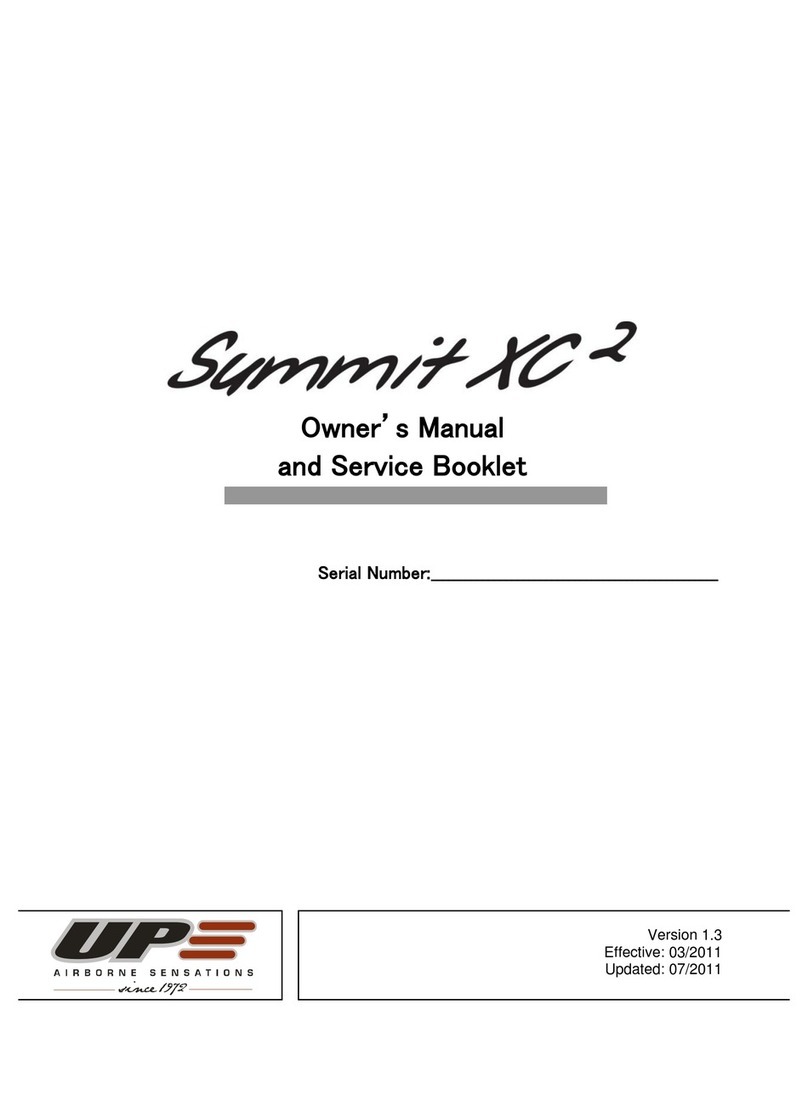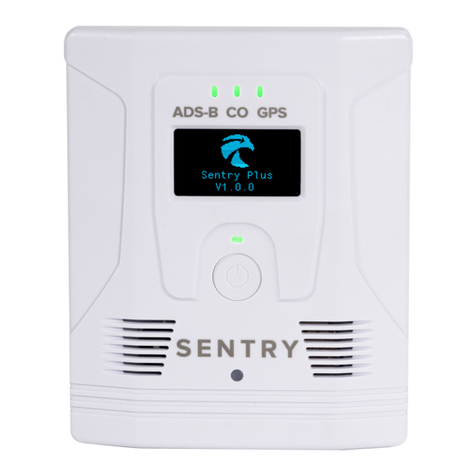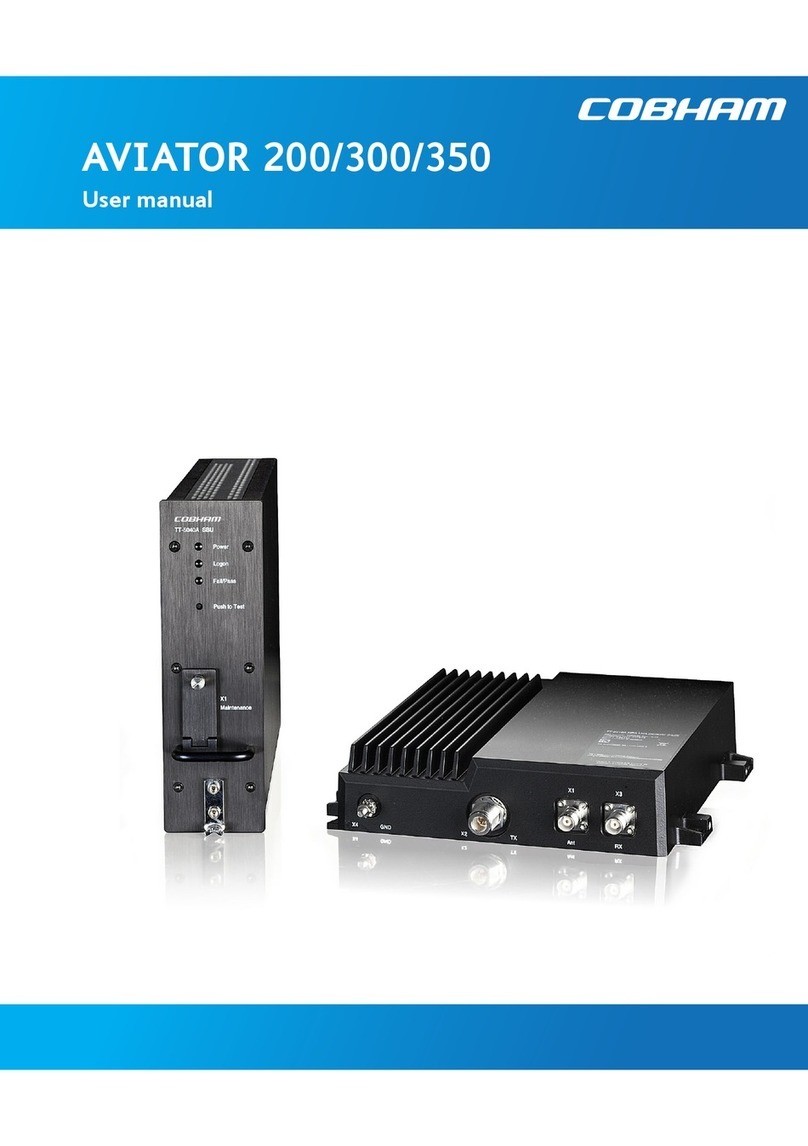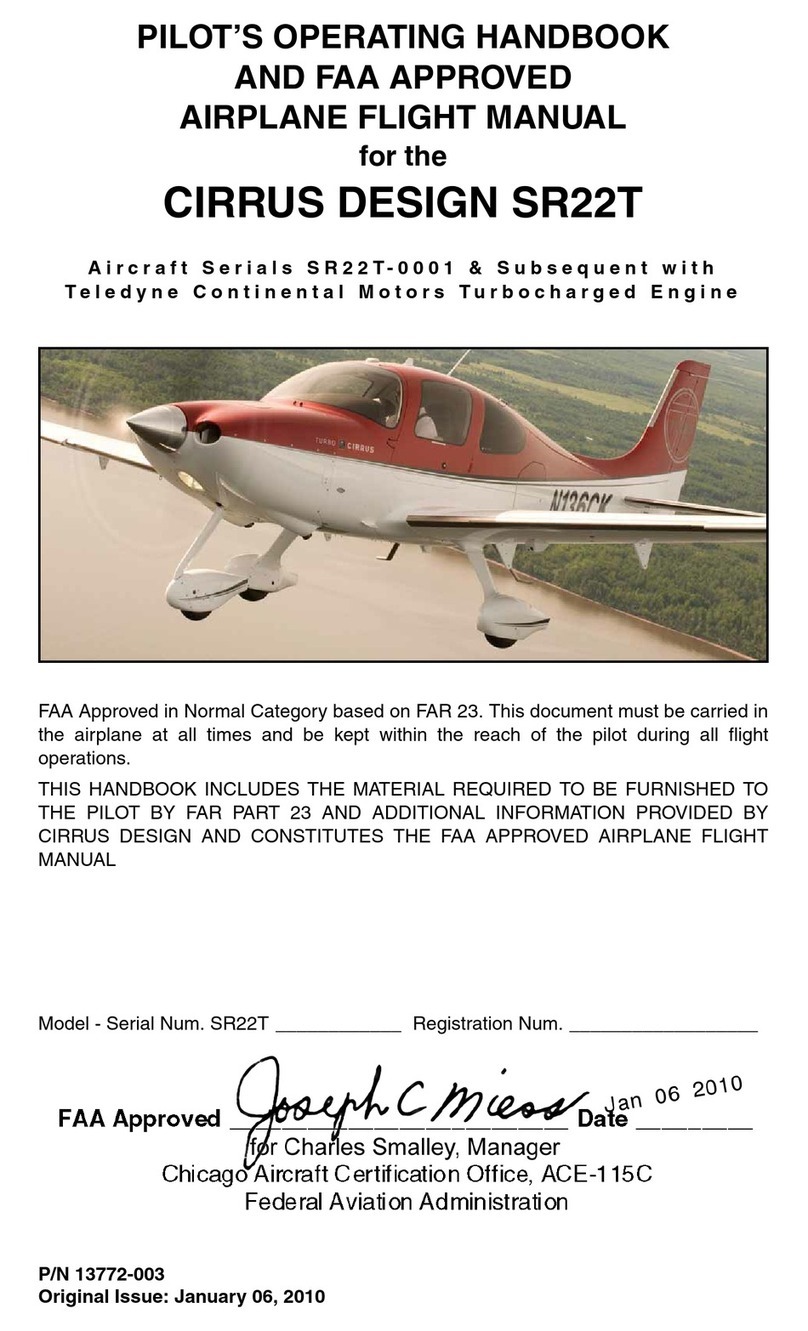Triple Seven D-LIGHT Series User manual

d-light
The lightes safety

USER MANUAL
Version 1.2, Date: 01.04.2017
The lightest safety
EN/LTF-A

Introduction
Welcome
Welcome to the Triple Seven Team! We’re excited that you
have chosen to y the D-light, and we are certain that
this glider will be the perfect lightweight choice for you,
all the way from hill training to cloud base. The D-light is
developed for maximum safety and ease of use, in a light
package. As such, this glider is ideal for weight-conscious
pilots just embarking on their rst paragliding adventures.
It is designed to be your rst lightweight glider, to take
you on breathtaking hike&y adventures, on your rst XC
ights or any other direction you might take in paragliding.
We wish you exciting ying adventures!
Triple Seven Mission
Our company goal is to produce high quality products and
technologically innovative gliders of all types and classes.
We are striving to develop state-of-the-art paragliders,
with the optimum compromise between safety and
performance. Your success is our inspiration; our goal is
your success.
Manual
This document contains all the important product
information and instructions to help you become familiar
with the main characteristics of your new paraglider. It
contains instructions on how to use and maintain the
wing, but its purpose is not to teach you to pilot this kind
of wing. This is not a ying manual. Flying is taught by
paragliding schools and certied instructors.
It is important that you take the time to read this manual
carefully before the rst ight, as thorough knowledge of
your equipment enables you to y safely and to maximize
your full potential. If you lend or sell your glider to another
pilot, please pass this manual on with it.
If any use of Triple Seven equipment remains unclear
after having read this manual, please contact: your local
paragliding instructor, your Triple Seven importer or Triple
Seven. This product manual is subject to changes without
prior notice. Please check www.777gliders.com for the
latest information regarding our products.
Summary
1. Beginner of The Game EN/LTF-A
3
II. Introduction 4
II.i. Welcome 4
II.ii. Triple Seven Mission 4
3. D-light 7
3.1. Who is this glider for? 7
3.2. Designers’ thoughts 8
3.3. Certication 9
4. Before flight 10
4.1. Elements, components 10
4.2. Assembly 10
4.3. Harness 11
4.4. Accelerator settings 11
4.5. Brake adjustments 11
4.6. Weight range 12
4.7. Wing ination 12
4.8. Modications on the glider 12
4.9. Preight safety 12
5. Flying D-light 13
5.1. First Flight 13
5.2. Preight equipment check 13
5.3. Final preight check 14
5.4. Ination, control, take-off 14
5.5. Line knots or tangles 14
5.6. Normal ight, best glide 15
5.7. Minimum sink 15
5.8. Accelerated ight 15
5.9. Active ying 15
5.10. Flying in turbulence 16
5.11. Fast descent techniques 17
5.12. Tow launch 19
5.13. Aerobatics 19
5.14. Primary controls failure 19
5.15. Landing 19
6. Maintenance 20
6.1. General advice 20
6.2. Packing instructions 20
6.3. Storage 21
6.4. Cleaning 21
6.5. Repair 21
6.6. Checks and control 21
VII. Packing D-light 22
8. Technical data 24
8.1. Technical data 26
8.2. Materials description 26
8.3. D-light risers arrangement 27
8.4. Line plan D-light 28
8.5. Line lengths D-light L 29
8.6. Line lengths D-light M 30
8.7. Line lengths D-light S 31
8.8. Certication specimens 32
IX. Safety and responsibility
36
X. Guarantee 37
XI. Registration information 38
XII. Get involved 38
XIII. Contact 39
XIV. Top 5 tips 41

9
8
Designers’ thoughts
Our design goal with the D-light was to make the world of lightweight
hike&y paragliding available to everyone, right from the rst little
hops on the training hill. It is both a good, balanced school glider
with easy takeoff, ying and landing characteristics, and a perfect
companion for all sorts of Hike&Fly adventures. During the design
and development process we took the new glider on many of our own
little para-alpinism outings, and rened it until it t our expectations
perfectly. The D-light has a nice clean canopy shape, featuring
diagonal ribs for line reduction and mini-ribs for clean trailing edge
shape. The entire design is optimised for minimal weight in a very
user-friendly package.
Aljaž and Urban Valič
The D-light is EN-A, LTF-A class glider designed for weight-
conscious beginners and intermediate pilots. This glider is
developed for lightness combined with maximum safety. Our
focus with this glider was on lightweight XC abilities, and we
believe that pilots will have great fun during their rst steps
in paragliding and progression toward becoming the new
Hike&Fly and XC masters.

16 17
risk of a collapse is higher in accelerated ight. Additionally, the
reaction of the glider to a collapse in accelerated ight is more
dynamic compared to one which occurs at trim speed.
We recommend avoiding accelerated ight near the ground and to
be very alert when using the accelerator in turbulent conditions.
Use a soft speed bar, which enables you to accelerate the glider
by using only one leg., and use weight shift to control the direction.
To control the pitch, change the amount of speed bar. Do not use
or pull the brakes while using the speed bar. Use the speed bar
progressively when accelerating, and instantly release when you
feel a slight loss of tension, pressure or even a collapse. If you
encounter a collapse while using the accelerator, release the speed
bar immediately before taking any other corrective action. Always
keep more distance from the ground when using the speed bar.
Active ying
This is a basic ying technique for any pilot. It implies permanent
control and the correction of pitch and roll movements together
with the prevention of any deations or collapses. In a nutshell
this means ying straight through active or turbulent air, so that
the pilot keeps the glider vertically above their head at all times,
compensating and correcting any unwanted movements of the
wing.
Few examples:
• While entering a strong thermal, the wing will stay a little bit
behind relative to the pilot. The pilot should ease the brakes
up, allowing the wing to y faster and to catch up.
•
If the wing surges in front of the pilot, the pilot should counter
brake until the surge is controlled and then release the brakes
to let the glider y normally.
•
If the pilot feels a loss of tension on the wing or a loss of
pressure on the brakes on one side of the wing, he should
smoothly apply the brake on the side with loss of pressure and/
or weight shift to the opposite side until the pressure returns.
After that, again release the brake and/or weight shift to the
neutral position and let the glider y normally.
The key in all cases is to avoid an over-correction and not to
maintain any correction longer than necessary. After each action
let the glider y normally again, to re-establish its required ying
speed. You can train or get a feeling for most of these movements
safely on the ground while ground handling your glider. Good
coordination of your movements and coordination with the wing
on the ground will enable you a quick progression when actively
ying in the air. The next step is to attend SIV clinics, where you
should also get a better understanding of the full brake range and
the glider’s speeds.
Flying in turbulence
Wing deations (collapses) can occur in strong turbulence. The
D-light is designed and tested to recover without pilot input in
almost all situations, by simply releasing the brakes and letting the
glider y. To train and understand all the manoeuvres described,
attend SIV clinics.
Cascade of events
Many reserve deployments are the result of a cascade of
over-corrections by the pilot. Over-corrections are usually not
problematic because of the input itself or its intensity; but more
due to the timing of the pilot input. After every input you have to
allow the wing to re-establish its normal ying speed. Note that
over-corrections are often worse than no input at all, particularly
on EN A wings like the D-light.
Asymmetric deflations
Strong turbulence may cause the wing to collapse asymmetrically.
Before this occurs the brake lines and the feeling of the harness
will transmit a loss of pressure to the pilot. This feedback is used
in active piloting to prevent a collapse. If the collapse does occur,
the D-light will easily re-inate without pilot reaction, but the
wing will turn towards the collapsed side. To prevent this from
happening, turn and actively recover the asymmetric collapse by
weight shifting and applying appropriate brake input on the side
that is still ying. Be careful not to over-brake your wing’s ying
side. This is enough to maintain your course and give the glider
enough time to recover the collapsed side by itself. To actively
reopen the collapsed side after course stabilization, pull the brake
line on the collapsed side rmly and release it. You can do this
several times with a smooth pumping motion. After the recovery,
release the brake lines for your glider to regain its trim speed. Note
that asymmetric collapses are much more dynamic when ying
accelerated. This is due to the difference in weight and resulting
inertia of the (light) canopy and the (heavy) pilot hanging below.
Symmetric deflations
Symmetric or frontal deations normally reopen immediately
by themselves without pilot input. The glider will then regain its
airspeed accompanied by a small surge forwards. To actively
control this event, apply both brakes slightly when the collapse
occurs and then instantly release the brakes to let the glider y.
Be prepared to compensate for a slight surge forward while the
glider regains normal ying speed.
Wing tangle, cravat
The D-light is very unlikely to cravat, but it may occur after a
severe deation or in a cascading situation, when the wing tip gets
caught in the lines. Pilots should be familiar with the procedure for
handling this situation with any glider. Familiarize yourself with the
stabilizer main line (“stabilo” line, orange colour) while unpacking
and preparing the wing. If a cravat occurs, the rst thing to do is
to try to keep the glider ying in a straight line. Do this by weight
shifting and counter braking the untangled side. After that, grab
the stabilizer main line on the tangled side, pull it down until it
becomes tight again. At this point the cravat normally releases
itself.
Possible solutions of the cravat situations (consult your SIV
instructor):
• Pulling the wing tip “stabilo” line
• Using a full stall, but it is essential to be very familiar with this
manoeuvre. You also want to have a lot of altitude.
• If you are in a situation where you have a cravat and you are low
in rotation or even with twisted risers, then the only solution is to
deploy the reserve parachute.
Negative spin
In normal ight you are far from negative spin. But, certain
circumstances may lead to it. Should this occur, just release the
overbraked line progressively and let the wing regain ying speed.
Be prepared for a canopy surge forward, and compensate the
surge with brake input if necessary.

18 19
Full stall
A full stall does not occur unintentionally on its own – it happens
if you pull both brakes all the way below the seat and hold them
there. The wing then performs a so called full stall. Releasing the
brakes improperly
may in rare cases lead to a massive surge of the glider, with danger
of falling into the canopy. The full stall is a complex manoeuvre
and as such outside the scope of this manual. You should practice
and learn this
manoeuvre only during SIV clinics, under professional tuition.
Deep stall
Generally when in deep stall, the wing has no forward motion and
at the same time high sink speed. When in deep stall the wing
is almost fully inated, but looks “limp” and creased from below.
The D-light is very unlikely to get into a deep stall unintentionally,
but under rare circumstances it could possibly happen if you are
ying at a very low speed in turbulent conditions. Also the porosity
of the material and line stretch on a very old glider can increase
the risk of deep stall. If you have already trained this manoeuvre
during an SIV clinic you probably know that it is very hard to keep
the D-light in deep stall, because as soon as you apply a little bit
more brake you immediately enter a full stall phase, and if you
release the brakes just a little bit too much the wing returns to
normal ight. If you want to practice the deep stall on SIV courses,
you need to master the full stall rst.
Fast descent techniques
Fast descent techniques should be familiar to any pilot, as
they are important tools to be used in certain situations. These
manoeuvres should be trained as a part of the normal paragliding
pilot training at your ying school. We also recommend practicing
these manoeuvres during SIV clinics, under professional tuition.
Big ears
This is a safe method to moderately loose altitude while still
maintaining forward speed. To do big ears, release any brake line
loops around your wrist, set your leg on the speed bar, but do not
push it. Now pull the outer A lines (the A2 risers in the drawing)
on both sides. As long as you keep the A2 risers pulled, the wing
tips stay folded and the sink rate increases. To return to normal
ight, release the A2 risers, and if necessary apply the brakes with
short pumping movements. Release big ears at least 100 meters
above the ground. While using big ears, the wing speed decreases,
which is why we also recommend using the accelerator half way
in combination with big ears to maintain enough horizontal speed
and to also additionally increase vertical speed. Be careful not to
pull the brakes while making the ears! Steering is done by weight
shift only. Always do the big ears rst and then accelerate; not the
other way around as you risk getting a frontal collapse.
B line stall
While in the B-stall the glider has no horizontal speed and the
sink rate increases to about -8m/s. To enter the B-stall reach
for the B risers just below the maillons and pull both B line
risers symmetrically for about 20 cm. To exit the manoeuvre,
simultaneously release both risers quickly. On exit the D-light
gently surges forward, without deep stall tendencies.
Spiral dive
The spiral dive is the most demanding of all three manoeuvres
(Big ears, B-stall, Spiral) and should only be trained gradually and
always high above the ground. The spiral dive should be practiced
and learned on a SIV course under professional tuition. To enter
the spiral, weight shift to the desired side and gradually apply the
brake on the same side. Then let the wing accelerate for two turns
and you will enter the spiral dive.
While in the spiral, control your descent rate and bank angle by
applying more or less inside brake. Depending on how steep the
spiral is you may need to apply outer brake. To exit the spiral dive
we recommend returning to a neutral weight shift position. If you
release the inner brake, the wing exits the spiral dive by itself.
The D-light has no tendency to remain stable in a spiral, but you
should always be aware of the correct procedure for exiting a
stable spiral.
To exit a stable spiral dive, weight shift to the opposite side of
the turn and apply the outer brake until feeling the deceleration of
the wing rotation. Then release the outer brake and let the glider
decelerate for the next couple of turns. To avoid a big pendulum
movement after exiting the spiral, apply a short brake input on
the inner side before the glider exits the spiral.
Warnings (Spiral dive):
•
There is a possibility of losing consciousness while in a spiral
dive. Never make a spiral with more than -16 to -18m/s vertical
speed.
•
In fast spirals it may be necessary to apply the outer brake to
begin exiting the spiral dive.
• If practicing the spiral dive low, a pilot may not have enough
altitude or time to safely exit this manoeuvre.
Winch launch
The D-light is easy to launch using a winch and has no special
characteristics considering this kind of launching. To practice this
launching technique, special training is needed and you need to
be aware of the procedures and dangers specic for winching.
We do not recommend using any special towing device which
accelerates the glider during the winch launch.
Aerobatics
The D-light was not designed for aerobatics, therefore, these
should not be performed on this glider. In addition to this, any
extreme manoeuvres place unnecessary stress on the glider and
shorten its lifespan.
Primary controls failure
If for any reason you cannot use the brake lines, you have to pilot
the wing to the landing place by using weight shift. Weight shift
should be enough to safely land the glider. You can also use the C
risers to control and steer the wing. Be careful not to over-handle
the glider by using the C riser technique when steering. By pulling
the C risers too far you may cause a stall or a negative spin.
Land your glider at trim speed without using the C risers, to avoid

20 21
over-handling the glider low above ground. We recommend using
only weight shift.
Landing
Similarly to the take-off, the D-light’s landing characteristics are
easy. In turbulent conditions it is advisable to apply about 15% of
brake, to increase stability and the feeling of the glider.
Before landing, adopt the standing position as this is the most
effective and the safest way to compensate the touch down with
your legs. Again we recommend training the landing manoeuvre,
as it might be useful to be able to land in small places, especially
in an unknown cross country terrain. Learn to evaluate the wind
direction by observing the signs on the ground and your drift
while making turns. This is useful for cross country, when landing
away from your usual landing eld. Another advice we suggest
taking into account in stronger winds is to head for the landing
eld earlier, thus making sure you reach them. Likewise, always
look for possible alternatives downwind.
Maintenance
General advice
Careful maintenance of your glider and the following simple
guidelines will ensure a much longer airworthiness and performance
of your wing:
•
Pack your glider after you land and do not expose it to
unnecessary UV radiation, by leaving it unpacked in the landing.
The sun UV radiation degrades the cloth and line material.
•
Fold your glider as recommended under “Packing instructions”
below.
• If the glider is damp or wet when you pack it, partially unfold
it at home to allow it to dry. Do not dry it in direct sunlight.
•
Avoid exposing the glider to violent shocks, such as the leading
edge hitting the ground.
•
Avoid dragging the glider on the ground or through rocky
terrain as you might damage the lines or canopy.
• Avoid stepping on the lines or canopy, especially when they
are lying on a hard surface.
•
Avoid exposing the glider to salt water, as it damages the lines
and the canopy material (wash with fresh water).
• Avoid bending your lines, especially in a small radius.
•
Avoid opening your glider in strong winds without rst
untangling the lines.
•
In general, avoid exposing your glider to very hot or humid
environments, UV radiation or chemicals.
Packing instructions
It is important to pack your glider correctly, as this prolongs its
lifespan. We recommend that you fold the glider like an accordion,
neatly aligning the cell walls with the leading edge reinforcements,
side by side. The wing should then be folded in three parts or two
folds. The wing should be packed as loosely as possible. While
packing be careful not to trap any grasshoppers inside your canopy
as they will chew through the canopy cloth. By adhering to these
few simple guidelines you ensure that your glider last longer and
preserves its best performance. for longer.
Storage
Correctly packed, store your glider in a dry place at room
temperature. The glider should not be stored damp, wet, sandy,
salty or with objects inside the cells of the glider. Keep your
equipment away from any chemicals.
Cleaning
If necessary always clean your glider with fresh water and a cloth
only, without using any cleaning chemicals. This includes both
lines and canopy. More importantly, always remove stones or
sand from the canopy as they will gradually damage the material
and reduce the glider’s lifespan.
Repair
To repair small damages (less than 5cm) to the canopy, you may
use rip stop repair patches. Greater damages, including damage
to stitches and lines, should be repaired by a specialized repair
shop. Damaged lines should be replaced by a Triple Seven dealer.
When replacing a line it should always be compared with the
counterpart for adjusting the appropriate length. After the line was
repaired, the wing should be inated before ying, to ensure that
everything was done correctly. Major repairs, such as replacing
panels, should only be carried out by a Triple Seven distributor or
Triple Seven. If you are unsure about the damage or in any doubt
please contact Triple Seven.

2222
Packing the Triple Seven D-light
23
1. FOLD THE GLIDER LIKE HARMONICA
2. ALIGN THE CELLS
3. FOLD LEADING EDGE BACK TOWARD TRAILING EDGE AND ALIGN THE CELS
4. FOLD THE GLIDER IN THREE PARTS
5. FINISHED

24 25
Technical data
1. Suspension lines
2. Risers
3. Main lines
4. Middle cascades
5. Upper cascades
6. Brake lines
1. Canopy
2. Bottom surface
3. Top surface
4. Leading edge
5. Trailing edge
6. Intake cell openings
1.
2.
3.
6.
4.
5.
3.
2.
6.
5.
4.
1.

26 27
Technical data Materials description
SIZE D-light S D-light M
CELLS NUMBER 29 29
ASPECT RATIO 4.4 4.4
PROJECTED AREA m220.1 23.2
SPAN 7.85 8.39
RISERS A B C
D-light S LENGTHS (mm) 520 520 520
D-light S LENGTHS (mm) 390 423 520
S-Distance between
pulleys: 130
D-light M LENGTHS (mm) 550 550 550
D-light M LENGTHS (mm) 410 455 550
M-Distance between
pulleys: 140
D-light L LENGTHS (mm) 580 580 580
D-light L LENGTHS (mm) 430 477 580
L-Distance between
pulleys: 150
SIZE D-light S D-light M
TRIMS NO NO
IN FLIGHT WEIGHT MINIMUM kg 60 80
MAXIMUM kg 85 105
GLIDER WEIGHT kg
CERTIFICATION EN/LTF A A
CANOPY FABRIC CODE
Upper surface SKYTEX 27
Bottom surface SKYTEX 27
Proles SKYTEX 27 HARD
Diagonals SKYTEX 27 HARD
Internal construction D-Ribs,
H-Straps, Mini ribs SKYTEX 27 HARD
Thread Seral 40/2000, 60/2000
SUSPENSION LINES FABRIC CODE
Upper cascades PPSL 125, DSL 70
Middle cascades PPSLO 191 / PPSL 191,128, 70
Main TSL 380, 280, 220, 190
Brake lines PPSL 125, DSL 70
Main brake PPSL 200
Thread Seral Amann 60/0415
RISERS FABRIC CODE
Material Dyneema
Color indicator Cordura 200/200PU
Brake Swivel Tylaska
Maillons Dyneema
Pulleys
Speed: 4 x Finsterwalder Mini role metal
28mm, Brake: 2 x Riley plastic 35mm
1. A1 riser
2. A2 riser, (Ears)
3. B riser, (B-Stall)
4. C riser
5. Maillons
6. Main attachment point
7. Speed bar attachment point
8. Speed bar pulleys
9. Brake handle
10. Brake line pulley
11. Main brake line
12.
Brake handle attachment loop
D-light risers
1.
4.
3.
2.
10.
6.
7.
12.
5.
9.
11.
8.

29
28
Line lengths D-light S
Line plan D-light Triple Seven D-light S Lines Length (mm) LINE CHECK
First gallery a1 5764 c1 5792 br1 6616
Lines A mm Lines B mm Lines C mm Lines D mm BR lines mm a2 5702 c2 5734 br2
6386
a1 1082 b1 983 c1 1120 d1 1298 br1 956 a3 5694 c3 5725 br3 6168
a2 1020 b2 919 c2 1061 d2 1245 br2 726 a4 5737 c4 5765 br4 6142
a3 1012 b3 909 c3 1053 d3 1233 br3 907 a5 5733 c5 5741 br5
5996
a4 1055 b4 954 c4 1093 d4 1263 br4 881 a6 5698 c6 5710 br6 5815
a5 1051 b5 948 c5 1069 d5 1237 br5 855 a7 5699 c7 5704 br7
5692
a6 1016 b6 913 c6 1037 d6 1198 br6 674 a8 5734 c8 5747 br8
5620
a7 1017 b7 915 c7 1031 d7 1188 br7 755 a9 5703 c9 5684
a8 1052 b8 952 c8 1074 d8 1128 br8 683 a10 5628 c10 5608
a9 1017 b9 936 c9 1011 d9 898 a11 5568 c11 5545
a10 942 b10 860 c10 935 d10 1170 a12 5523 c12 5499
a11 882 b11 806 c11 872 a13 5095 c13 5034
a12 837 b12 770 c12 827 a14 5024 d1 5967
a13 1135 b13 1163 c13 1073 b1 5669 d2 5914
a14 1063 b14 1062 b2 5604 d3 5903
b3 5595 d4 5933
Second gallery b4 5640 d5 5907
Lines A mm Lines B mm Lines C mm Lines D mm BR lines mm b5 5633 d6 5868
1a1 1061 1b1 1061 1c1 1061 1br1 1648 b6 5599 d7 5858
1a2 1061 1b2 1061 1c2 1061 1br2 1248 b7 5601 d8 5798
1a3 1061 1b3 1061 1c3 1061 1br3 1107 b8 5638 d9 5568
1a4 1061 1b4 1061 1c4 1061 1br4 903 b9 5622 d10 5128
1a5 1061 1b5 1061 1c5 1061 b10 5546
1a6 1061 1b6 1061 1c6 1061 b11 5492
Stab1 796 Stab2 796 b12 5456
Main Lines Main stabilo 3165 b13 5123
Lines A mm Lines B mm Lines C mm Lines D mm BR lines mm BR main mm b14 5023
2a1 3630 2b1 3900 2c1 3630 2br1 1904 2br1 2130
2a2 3630 2b2 3900 2c2 3630 2br2 1926
2a3 3630 2b3 3900 2c3 3630

30 31
Line lengths D-light M
Triple Seven D-light M Lines Length (mm) LINE CHECK
First gallery a1 6192 c1 6223 br1 7108
Lines A mm Lines B mm Lines C mm Lines D mm BR lines mm a2 6126 c2 6160 br2
6861
a1 1162 b1 1056 c1 1203 d1 1394 br1 1027 a3 6117 c3 6151 br3
6626
a2 1096 b2 987 c2 1140 d2 1337 br2 780 a4 6163 c4 6194 br4
6598
a3 1087 b3 977 c3 1131 d3 1325 br3 974 a5 6159 c5 6168 br5
6442
a4 1133 b4 1025 c4 1174 d4 1357 br4 946 a6 6122 c6 6134 br6
6247
a5 1129 b5 1018 c5 1148 d5 1329 br5 919 a7 6123 c7 6128 br7 6115
a6 1092 b6 981 c6 1114 d6 1287 br6 724 a8 6160 c8 6174 br8
6038
a7 1093 b7 983 c7 1108 d7 1276 br7 811 a9 6127 c9 6106
a8 1130 b8 1023 c8 1154 d8 1212 br8 734 a10 6046 c10 6025
a9 1093 b9 1006 c9 1086 d9 965 a11 5982 c11 5957
a10 1012 b10 924 c10 1005 d10 1257 a12 5933 c12 5908
a11 948 b11 866 c11 937 a13 5474 c13 5408
a12 899 b12 827 c12 888 a14 5397 d1 6411
a13 1219 b13 1249 c13 1153 b1 6090 d2 6354
a14 1142 b14 1141 b2 6021 d3 6342
b3 6011 d4 6374
Second gallery b4 6059 d5 6346
Lines A mm Lines B mm Lines C mm Lines D mm BR lines mm b5 6052 d6 6304
1a1 1140 1b1 1140 1c1 1140 1br1 1770 b6 6015 d7 6293
1a2 1140 1b2 1140 1c2 1140 1br2 1341 b7 6017 d8 6229
1a3 1140 1b3 1140 1c3 1140 1br3 1189 b8 6057 d9 5982
1a4 1140 1b4 1140 1c4 1140 1br4 970 b9 6040 d10 5512
1a5 1140 1b5 1140 1c5 1140 b10 5958
1a6 1140 1b6 1140 1c6 1140 b11 5900
Stab1 855 Stab2 855 b12 5861
Main Lines Stabilo Lines b13 5504
Lines A mm Lines B mm Lines C mm Lines D mm BR lines mm BR main mm b14 5396
2a1 3900 2b1 3900 2c1 3900 2br1 2046 2br1 2265
2a2 3900 2b2 3900 2c2 3900 2br2 2069
2a3 3900 2b3 3900 2c3 3900
Line lengths D-light L
Triple Seven D-light L Lines Length (mm) LINE CHECK
First gallery a1 6489 c1 6530 br1 7458
Lines A mm Lines B mm Lines C mm Lines D mm BR lines mm a2 6420 c2 6464 br2 7199
a1 1219 b1 1108 c1 1262 d1 1463 br1 1078 a3 6411 c3 6454 br3
6953
a2 1150 b2 1036 c2 1196 d2 1403 br2 818 a4 6459 c4 6499 br4
6923
a3 1141 b3 1025 c3 1187 d3 1390 br3 1022 a5 6455 c5 6472 br5 6760
a4 1189 b4 1076 c4 1232 d4 1424 br4 993 a6 6416 c6 6436 br6
6555
a5 1185 b5 1068 c5 1205 d5 1395 br5 964 a7 6417 c7 6430 br7 6416
a6 1146 b6 1029 c6 1169 d6 1350 br6 760 a8 6456 c8 6478 br8
6336
a7 1147 b7 1031 c7 1163 d7 1339 br7 851 a9 6421 c9 6407
a8 1186 b8 1073 c8 1211 d8 1272 br8 770 a10 6336 c10 6322
a9 1147 b9 1056 c9 1140 d9 1013 a11 6269 c11 6251
a10 1062 b10 970 c10 1055 d10 1319 a12 6217 c12 6199
a11 995 b11 909 c11 983 a13 5744 c13 5671
a12 943 b12 868 c12 932 a14 5657 d1 6727
a13 1279 b13 1311 c13 1210 b1 6390 d2 6667
a14 1198 b14 1197 b2 6318 d3 6655
b3 6307 d4 6688
Second gallery b4 6358 d5 6659
Lines A mm Lines B mm Lines C mm Lines D mm BR lines mm b5 6350 d6 6615
1a1 1196 1b1 1196 1c1 1196 1br1 1857 b6 6312 d7 6603
1a2 1196 1b2 1196 1c2 1196 1br2 1407 b7 6314 d8 6536
1a3 1196 1b3 1196 1c3 1196 1br3 1248 b8 6356 d9 6277
1a4 1196 1b4 1196 1c4 1196 1br4 1018 b9 6338 d10 5783
1a5 1196 1b5 1196 1c5 1196 b10 6252
1a6 1196 1b6 1196 1c6 1196 b11 6191
Stab1 897 Stab2 897 b12 6150
Main Lines Main stabilo 3568 b13 5771
Lines A mm Lines B mm Lines C mm Lines D mm BR lines mm BR main mm b14 5658
2a1 4086 2b1 4092 2c1 4092 2br1 2147 2br1 2392
2a2 4086 2b2 4092 2c2 4092 2br2 2171
2a3 4086 2b3 4092 2c3 4092

3636 37
Safety and responsibility
Paragliding is a dangerous and high risk activity, where safety depends on the person
practicing it. By purchasing this equipment you implicitly state that you are a certied
paragliding pilot, and you accept all risks involved in paragliding activities, including serious
injury and death. Improper use or misuse of paragliding equipment considerably increases
these risks.
The designer, manufacturer, distributor, wholesaler and retailer cannot and will not guarantee
your safety when using this equipment, or accept responsibility for any damage, injury or death
as a result of the use of this equipment. This equipment should only be used by qualied and
competent pilots or by pilots under supervision of qualied paragliding instructors. You must
not use this equipment if you are not trained.
You alone, as a qualied and competent pilot, must take full responsibility to ensure that you
understand the correct and safe use and maintenance of this paragliding equipment, to use
it only for the purpose that it was designed for, and to practice all proper safety procedures
before and during its use.
Guarantee
Triple Seven WARRANTY:
All Triple Seven paraglider products are fully warranted for 24 months against material defects
which are not the result of normal wear or accidental damage.

39 38
Contact
Triple Seven Gliders
Company: 777 jadralna padala d.o.o.
Address: Ulica Ane Ziherlove 10
Postal Code / City: 1000 Ljubljana
Country: Slovenia
Tel.: +386 40 777 313
Email: [email protected]
Online resources
For complete help, the latest news, product
information and support go to:
Official website:
www.777gliders.com
Facebook:
www.facebook.com/TripleSevenParagliders
Newsletter register:
www.777gliders.com/newsletter/subscriptions
Ask questions, make suggestions
General questions:
Registration information
To fully use all Triple Seven maintenance and warranty services you need to register your glider
on our website. Wanting to provide good product support, we invite you to do so, even if you
bought your glider second-hand.
Triple Seven Warranty & Product registration:
http://www.777gliders.com/tripleseven/support
Get involved
As a new Triple Seven pilot we invite you to contact us in case of any technical or practical
issues regarding equipment or techniques. We also invite you to send us your ying photos,
videos or even postcards. We would like to hear from you and your exciting adventures with
your new D-light! Finally, join our Facebook community and share the passion. Have fun!

40
Top 5 tips
1. Master your takeoff and ground handling techniques. This is great way to get a feeling for the glider
and basic active piloting skills while still safely on the ground.
2. Fly together with friends and have fun! Share exciting stories and ask questions to more
experienced pilots.
3. Safety rst, remember that its better to stay on the ground wishing to be in the air then to be in the
air wishing to be on the ground. The mountain will still be there tomorrow.
4. Step by step, practice your equipment and techniques. Climbing is the most important! Practice it,
especially in weak conditions, and don’t be afraid to bomb out.
5. Attend safety and XC courses and learn to y your glider safely.
“Gašper Prevc”

This manual suits for next models
2
Table of contents
Other Triple Seven Aircraft manuals
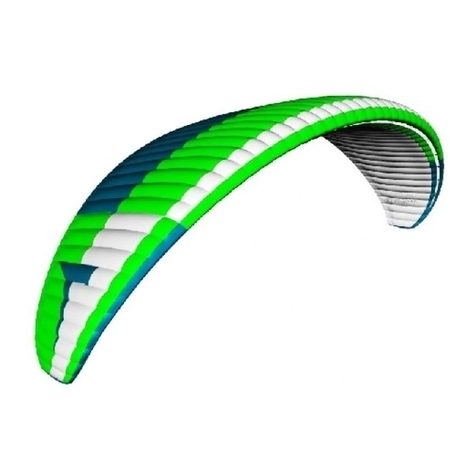
Triple Seven
Triple Seven KNIGHT Series User manual

Triple Seven
Triple Seven King 2 User manual

Triple Seven
Triple Seven Bishop 42 User manual

Triple Seven
Triple Seven DECK S User manual
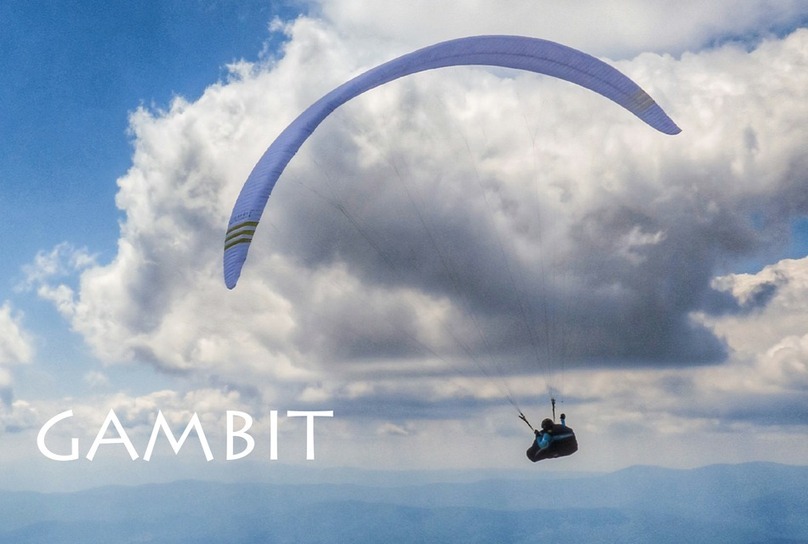
Triple Seven
Triple Seven GAMBIT User manual

Triple Seven
Triple Seven ROOK 777 XC SUPERSTAR User manual

Triple Seven
Triple Seven MATRIX User manual
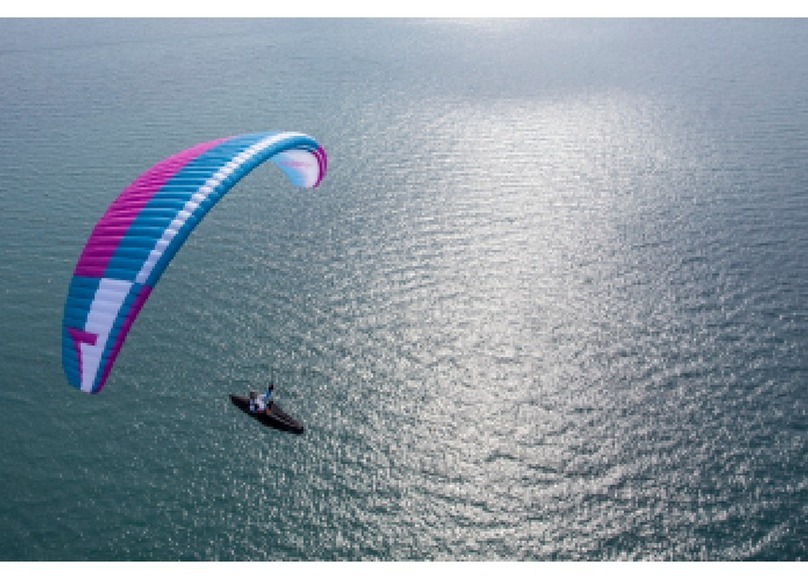
Triple Seven
Triple Seven ROOK2 User manual
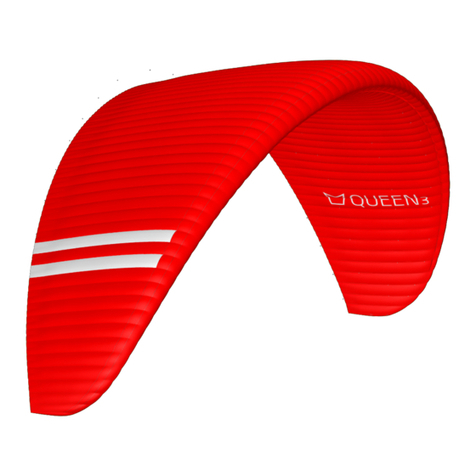
Triple Seven
Triple Seven Queen 3 User manual
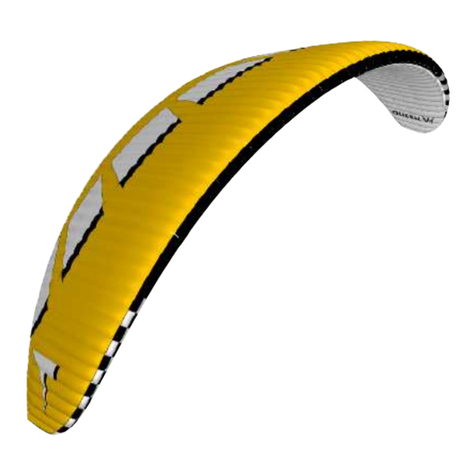
Triple Seven
Triple Seven QUEEN Series User manual
